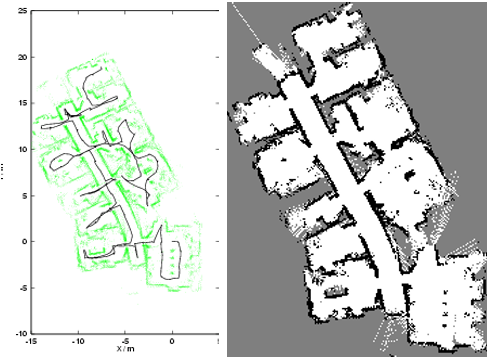




Did you find this useful? Give us your feedback



![Fig. 1. Raw sensor data from the Artificial Intelligence Lab, Freiburg, as in [6], showing the odometry trace and laser rangefinger readings.](/figures/fig-1-raw-sensor-data-from-the-artificial-intelligence-lab-nuy0b1il.png)





14 citations
..., 1996), map building (Duckett, 2003) and even pose tracking for robot localization (Moreno et al....
[...]
...Evolutionary algorithms (EAs), especially genetic algorithms, have been successfully used in different mobile robot applications, such as path planning (Chen & Zalzala, 1995) (Potvin et al., 1996), map building (Duckett, 2003) and even pose tracking for robot localization (Moreno et al., 2002)....
[...]
14 citations
...Closer to our research, GAs have been applied to early SLAM optimization problems [32], mobile localization using ultrasonic sensors [33] [34], and in deep reinforcement learning [35]....
[...]
13 citations
...Duckett (2003) introduce the genetic algorithm to a SLAM problem using laser scans. Mart́ınez et al. (2006) and Ze-Su et al. (2007) worked both on a mixed ICP algorithm aided by a genetic algorithm....
[...]
...Duckett (2003) introduce the genetic algorithm to a SLAM problem using laser scans....
[...]
11 citations
11 citations
...One of the first papers to address the SLAM problem using a genetic algorithm is [4]....
[...]
52,797 citations
32,573 citations
...GAs are a well-known search technique in which simplified, numerical forms of the biological processes of selection, inheritance and variation are used to improve the average fitness of the population through successive iterations [7]....
[...]
12,457 citations
...Genetic algorithms are particularly useful for solving environment modelling problems because they exploit the building block hypothesis, whereby better and better strings are constructed from the best partial solutions (i.e., schemata or building blocks) of previous generations [ 4 ]....
[...]
2,834 citations
2,358 citations
...[11] introduced a hybrid approach using a particle filter to track the pose of the robot, where each particle is associated with a set of Kalman filters estimating the position for each landmark....
[...]
A further possibility would be to combine the global search algorithm with a local optimization method, e. g., EKF [ 5 ], consistent pose estimation [ 10 ], relaxation [ 3 ], etc. A further possibility would be to investigate implementation of the algorithm on parallel processors, given the parallel nature of evolutionary computation. Future work should also include more detailed theoretical and empirical analysis of the problem and the algorithm required to solve it, e. g., with respect to the fitness criteria needed for different environments.